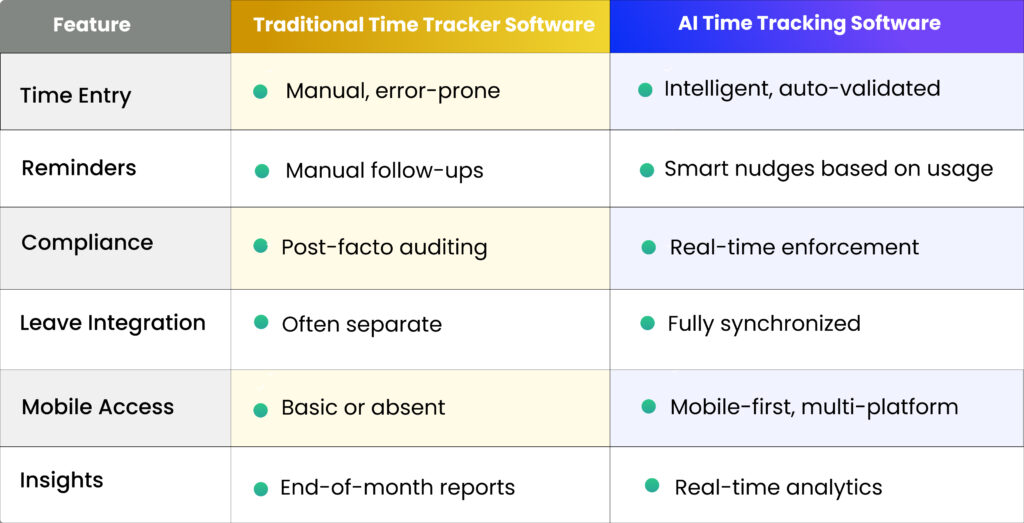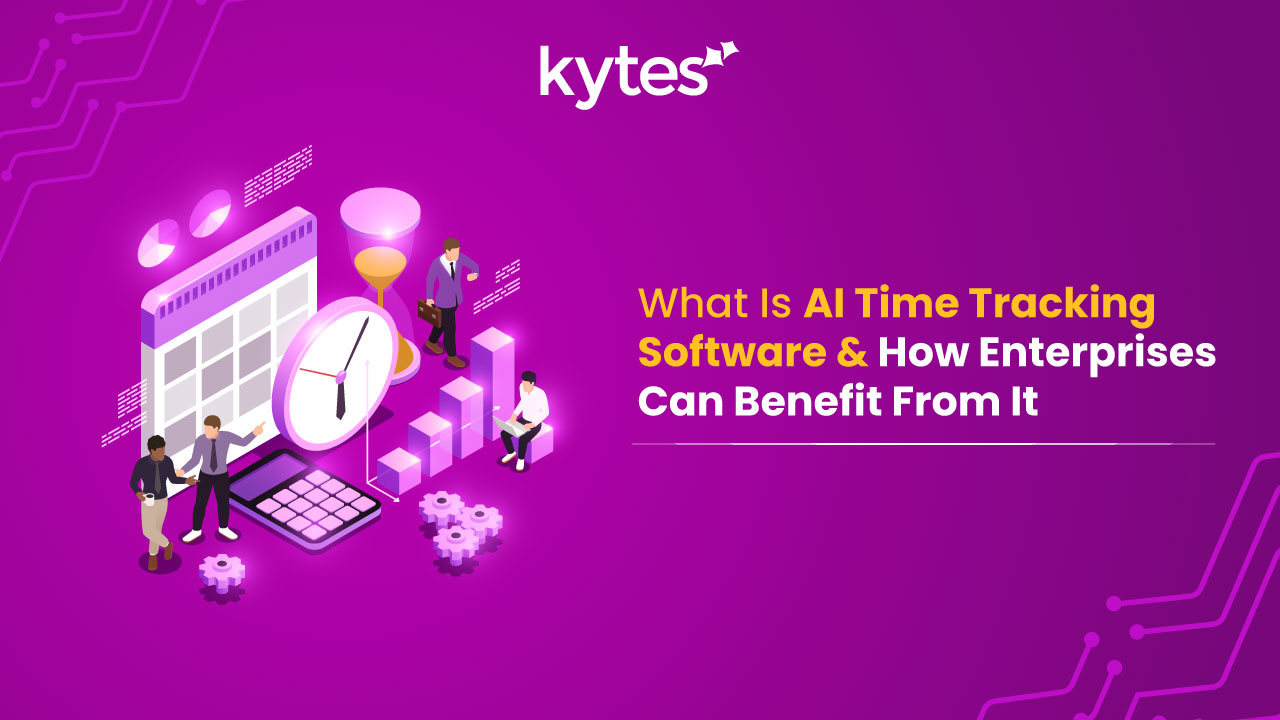Blog Highlights
- See how AI time tracking automates workforce time data beyond manual logging.
- Enables smart validations, behavior-based nudges, and seamless sync with payroll, billing, and leave.
- Aligns time data with productivity, performance, and financial goals.
- Cuts down admin effort and powers real-time, data-driven decisions.
- Discover how Kytes brings all this together to ensure compliance, efficiency, and scalable growth.
AI time tracking isn’t just another AI fad; it’s the need of the hour. In the fast-evolving world of hybrid workplaces and distributed teams, time has become more than just a number—it’s data. And not just any data, but the kind that influences payroll accuracy, billing cycles, compliance standards, productivity insights, and project profitability. For modern organizations, tracking time isn’t a support function anymore. It’s core to business execution.
This shift has contributed toward the increased use of AI time tracking software—a smarter, more integrated way to track, validate, and manage workforce effort. It goes far beyond the capabilities of traditional time tracker software by using artificial intelligence to bring consistency, compliance, and clarity to your operations.
In this blog, we’ll explore everything you need to know about AI time tracking software, how it compares to traditional tools, the benefits of using AI-powered systems, and how Kytes is transforming the employee experience, leadership decision-making, and global compliance.
What Is AI Time Tracking Software
AI time tracking software refers to timesheet tools and systems that use artificial intelligence technologies—such as machine learning, natural language processing, and predictive analytics—to automate and optimize the process of tracking employee hours, project effort, and time-related compliance.
Unlike traditional tools that rely on manual input and static approval flows, AI time tracking software intelligently:
- Validates entries against company policies
- Sends behavior-based reminders to employees
- Flags missing or inconsistent entries
- Predicts effort trends based on historical usage
- Supports smart, real-time decision-making
It doesn’t just log time—it learns from it, understands context, and drives continuous improvements across your workforce.
Why Traditional Time Tracking Tools Fall Short Today
Legacy systems offer basic start-stop time capture, static reports, and separate modules for attendance or leave. But in today’s global and compliance-heavy landscape, businesses are demanding more:
- Multi-country teams
- Flexible schedules and hybrid shifts
- Complex billing structures
- Region-specific labor laws
- Audit-readiness and policy enforcement
This is where AI-based employee time tracking software makes a difference.
Traditional vs. AI-Powered Time Tracking: A Quick Comparison

Key Capabilities of Modern AI Time Tracking Tools
To understand the power of modern work time tracking software, let’s explore its most valuable features:
1. Policy-Driven Validation
The system enforces rules such as:
- Minimum or maximum hours
- Shift overlap restrictions
- Tagging effort to valid billing codes or cost centers
- Project-specific logging rules
2. Behavior-Based Reminders
AI learns from user behavior. If an employee consistently misses their Friday log, the system can send smart nudges at the right time and through the preferred channel (email, app, or chat).
3. Integrated Leave and Attendance
AI time tracking software syncs with HRMS and leave modules. If an employee is on approved leave, their timesheet shows as such—no more reconciling manual entries with attendance reports.
4. Mobile-First Experience
Employees and managers can log, approve, and review time from anywhere—with full sync across devices and platforms.
5. Real-Time Analytics
Live dashboards provide insights into:
- Timesheet submission rates
- Project utilization
- Resource availability
- Time vs. budget variance
- Compliance deviations
6. Automated Approvals
Configurable workflows send entries through the right hierarchy based on department, geography, or project—reducing bottlenecks and manual follow-ups.
Use Cases: AI Time Tracking Across Industries
No matter your sector, time is a universal asset. Here’s how different industries benefit from AI time tracking tools and software:
🔹 IT & ITes
Billable projects rely on accurate time tracking. AI ensures no hours go unlogged, and clients are billed fairly.
🔹 Pharmaceuticals
Clinical trials and regulatory filings demand precise effort tracking, especially during audits. AI helps maintain data integrity.
🔹 Engineering & EPC
Large-scale construction or infrastructure projects require shift-based, site-specific time tracking. AI supports complex scheduling and validation.
🔹 Professional Services
Agencies need to track time across clients and contracts. AI simplifies multi-project logging and improves utilization insights.
How AI Time Tracking Drives Business Value Across Teams
Traditional tools require administrators to chase employees, validate hours, and manually generate reports. AI simplifies this by making time tracking:
- Proactive – identifying risks before they occur
- Autonomous – managing basic approval workflows
- Contextual – learning from past behavior to improve future accuracy
- Actionable – giving managers visibility to act in real time
Department-Wise Benefits of AI-powered Time Tracking
This drastically reduces administrative load, improves payroll and billing accuracy, and enhances employee compliance.
From HR and finance to project ops, AI-powered employee time tracking software goes beyond convenience. It solves some of the biggest challenges faced by HR, Finance, and Operations teams:
✅ Payroll Readiness
Only validated and approved entries feed into payroll, reducing salary errors and disputes.
✅ Compliance Assurance
Regional policies, break rules, and working hour limits are enforced automatically—reducing labor law violations.
✅ Leave Forecasting
By combining time, attendance, and leave data, the system helps teams forecast resource availability and avoid delivery gaps.
✅ Reduced Manual Intervention
Approvals, reminders, and validations are handled by the system—freeing up leadership for more strategic tasks.
Why AI Time Tracking Shouldn’t Work in Isolation
Time tracking can’t live in a silo.
In growing enterprises, disconnected systems—where time tracking, resource allocation, budgeting, and delivery operate independently—result in blind spots, duplications, and delays. That’s why embedding time tracking directly within a broader end-to-end project management system is no longer optional. It’s essential.
The Power of Connected Project Systems
An enterprise-grade platform that unifies time tracking with project planning, financials, resource management, and delivery execution offers more than convenience—it unlocks transformation.
Here’s what it enables:
- People + Projects: Resource managers can assign the right people to the right tasks while factoring in availability, approved leaves, and real-time effort logged.
- Time + Financials: Every approved hour gets automatically reflected in billing requests, payroll runs, and project cost sheets—ensuring traceability and audit readiness.
- Work + Productivity: Managers can correlate logged hours with task outcomes, project milestones, and overall productivity. It’s no longer about time spent—it’s about value delivered.
Everything Works in One Flow
When AI time tracking software is built into a comprehensive project system:
- Timesheet approvals feed into invoices
- Leave policies impact resourcing plans
- Logged hours inform revenue forecasts
- Utilization metrics guide hiring decisions
You don’t just save time—you make smarter, faster, and more profitable decisions.
Kytes is an enterprise-grade AI-enabled PSA+PPM software that is purpose-built to digitize the project lifecycle, automate routine workflows, and keep every moving part—from people to profitability—in sync.
How Kytes Streamlines Time, Leave & Attendance
Kytes AI-enabled PSA+PPM software provides intelligent time tracking, leave workflows, and attendance validation within a single, enterprise-grade ecosystem.
With Kytes, organizations get:
- Daily, weekly, or project-based time logging
- Shift-based calendars mapped across countries
- Leave types with region-specific rules and auto-accruals
- AI-powered nudges and error detection
- Seamless integration with billing, payroll, and HRMS systems
- Approval workflows with full audit trails
Kytes ensures that every hour logged is not only accurate but directly tied to cost, compliance, and resource planning.
Steps to Successfully Implement AI Time Tracking
To make the most of your investment, follow these steps:
1. Policy Definition
Start by documenting all time logging, leave, and compliance rules. This forms the blueprint for automation.
2. Stakeholder Alignment
Get buy-in from HR, Finance, Project Managers, and IT to ensure a smooth rollout.
3. Pilot Rollout
Test with a single department or team before scaling.
4. Training and Communication
Educate employees not just on how to use the software but why it benefits them.
5. Monitor Metrics
Track timesheet fill rates, policy violations, and time-to-approval as success indicators.
Kytes: More Than Just a Timesheet Tool
As businesses scale, their need for connected project systems increases. That’s why Kytes offers more than just time tracking. With its project portfolio, resource planning, financial integration, and analytics suite, Kytes becomes your control tower for project performance.
Time logs feed into:
- Billing and invoicing
- Resource utilization dashboards
- Payroll processing
- Client reporting
- Compliance audits
Everything is traceable, reportable, and AI-optimized.
Case Study: How Accurate Time Tracking Fuels Growth
In global professional services environments, accurate time tracking isn’t just a compliance need—it’s a direct lever for profitability, efficiency, and scalability.
Take ACB Staffing Inc., a global services company with over 6,000 employees and operations spanning multiple countries and legal entities. With consultants billing on monthly, daily, or hourly models, and working across time-and-material projects, the complexity of capturing accurate timesheets was massive. Disconnected systems, manual processes, and multi-country compliance made it challenging to ensure billing accuracy, manage leave liabilities, and maintain audit readiness.
When ACB adopted Kytes PSA, they streamlined:
- Consultant onboarding and time capture
- Customer approval workflows
- Region-specific leave policies down to 30-minute increments
- Payroll and billing across different frequencies
- Compliance with year-end adjustments and cost accounting
The result?
✔ Major reduction in manual effort
✔ Seamless approvals and accurate billing
✔ Improved compliance and employee satisfaction
✔ Revenue leakage plugged across geographies
Kytes unified what was once fragmented—enabling ACB to scale confidently with better visibility, higher utilization, and faster cash flow.
Curious how Kytes can streamline time tracking for your business?
The Competitive Edge with AI Time Tracking For CXOs
Time tracking isn’t just an operational task—when powered by AI, it becomes a strategic asset. Here’s what Kytes unlocks for business leaders:
- Real-time visibility into workforce utilization
- Accurate insights into project-level performance
- Early detection of delivery and capacity risks
- More accountability in effort reporting
- Smarter, data-backed decision-making
In essence, AI time tracking software transforms time from a passive record into a powerful business lever.
FAQs and Concerns: What Teams Ask About AI Time Tracking
❓ Will employees feel monitored?
No. AI enables freedom with structure. Employees aren’t tracked—they’re supported with smart nudges and automated validation.
❓ Will it replace human judgment?
Not at all. AI removes admin friction so managers can make better-informed decisions faster.
❓ Is AI time tracking hard to implement?
With platforms like Kytes, not at all. Pre-built templates, easy configuration, and dedicated support ensure a smooth go-live.
❓ Can it adapt to different locations and policies?
Yes. AI systems handle multi-country rules, shift patterns, leave types, and local compliance needs effortlessly.
Final Thoughts: Time Tracking for a Smarter Future
If your current system is only helping you record time, you’re missing out on a massive opportunity. With AI time tracking software, time becomes:
- Structured
- Actionable
- Linked to financial and strategic goals
- Transparent and easy for employees
- A single source of truth across the business
Kytes, with its AI-first foundation, is helping enterprises reimagine time not as a cost—but as a catalyst for performance.
So if you’re still relying on spreadsheets, outdated time tracker software, or disconnected systems—it’s time to ask: Is your time data building your business—or breaking it?





